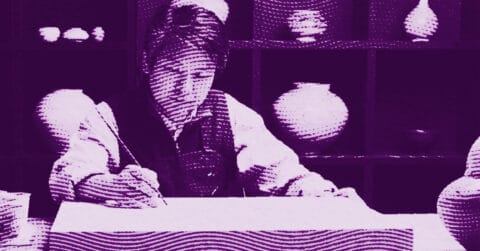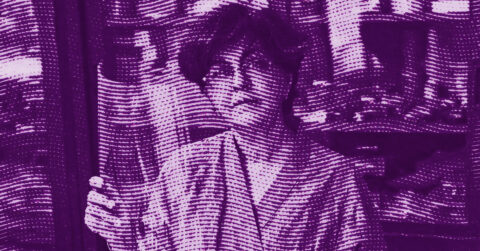Listen to me carefully, you bunch of snobs, it’s time to stop your intellectual pretenses and open your eyes wide to Joel Mesler, this American artist who taunts you with his paintings as brilliant as a California cocktail served by the pool in the 80s. Mesler is not one of those ephemeral comedians of the art market, although he has seen a meteoric rise, 900% increase in three years, as his dealers report with the subtlety of an elephant in a porcelain shop [1]. No, Mesler is a far more complex phenomenon, a former art dealer turned painter who transforms his childhood traumas into candy-colored paintings that collectors snatch up.
In Mesler’s universe, psychoanalysis and auteur cinema meet to form a unique artistic vision, where each canvas is a therapy session conducted under the spotlights of a Hollywood studio. If Freud had been director of photography for David Lynch, the result would probably resemble Mesler’s works, a surprising mix of repressed affects and carefully orchestrated aesthetics.
Let’s start with psychoanalysis, this science of psychic depths that would be very useful for decoding our artist’s work. Mesler does not hide the fact that his artistic production is anchored in a precise moment: the traumatic divorce of his parents, more specifically a scene at the Beverly Hills Hotel where his cocaine-addicted father overturned the breakfast table, throwing Benedict eggs on his mother’s dress [2]. A scene worthy of a Cassavetes film, but experienced by an 11-year-old child who would later become an artist obsessed with the Martinique wallpaper with banana leaf motifs, the very one that adorned the walls of that famous hotel.
In the purest psychoanalytic tradition, Mesler uses his artistic practice as a tool for healing. “I use the same green when I paint and I get that same green under my nails. Now, I have given myself power. I make money thanks to my trauma”, confesses the artist [3]. Here is an instrumentalization of trauma that would make Freud himself smile! Sublimation has never been so lucrative.
The wallpaper of the Beverly Hills Hotel has become for Mesler what the madeleine was for Proust, a sensory trigger that opens the floodgates of involuntary memory. But unlike the French writer, Mesler does not merely contemplate his memories: he transforms them into commodities sold at a high price. Psychoanalysis teaches us that the symptom can become enjoyment; in Mesler, it has become a business.
This transformation of trauma into a work of art is not unlike Alfred Hitchcock’s theories on managing anxiety: “I always make my characters go through what I am most afraid of myself.” Mesler applies this principle to his own life, he exposes his fears, his shames, and his weaknesses in paintings with joyful colors that catch the eye before troubling the mind. Lacanian psychoanalysis would speak here of a symptom disguised as a sinthome, that is to say, a suffering transformed into creation.
The letters and words that populate his canvases function as free associations, a technique dear to Freudian psychoanalysis. In his alphabetical series presented at the Simon Lee gallery, each letter is linked to a memory, a street in Los Angeles, a fragment of the past [4]. This fragmentation of the personal narrative into isolated symbolic units evokes the way traumatic memory is shattered and restructured.
If psychoanalysis helps us understand the foundations of Mesler’s work, auteur cinema offers us a key to reading his aesthetics. The artist himself claims this influence by describing his life as “the films Kramer vs. Kramer and Taxi Driver combined” [5]. This reference is not trivial. On one hand, Robert Benton’s family drama that explores the emotional consequences of divorce on a child; on the other, Scorsese’s portrait of a man alienated in a hostile city. Between these two poles lies Mesler’s pictorial universe.
The staging of his paintings recalls the careful compositions of a Wes Anderson, with their saturated colors and apparent naivety that conceals a deep melancholy. As in Sofia Coppola’s films, luxury and opulence serve as a backdrop for intimate dramas, disillusions, and losses of innocence. The pools that frequently appear in Mesler’s work function like those in David Hockney or Francois Ozon’s films, ambivalent symbols of pleasure and danger, of freedom and confinement.
The installation “Pool Party” planned for 2024 at the Rockefeller Center [6] perfectly illustrates this ambivalence. By transforming the emblematic ice rink into a fake pool, Mesler plays with the codes of California cinema, sun, blue water, beach balls, while subverting these postcard images through a contextual displacement that makes them slightly unsettling, as in a Lynch film.
The narrative techniques of auteur cinema are also found in the way Mesler structures his work in sequences and series. His recent exhibition at the Long Museum in Shanghai, titled “Spiritual Journey”, functioned as a pictorial road movie, where each canvas constituted a stage of an inner journey [7]. This fragmented, non-linear narration, where present and past merge, evokes the elliptical montages of a Terrence Malick.
Duality is at the heart of Mesler’s work, as it is at the heart of many auteur films. Light and darkness, emptiness and fullness, beginning and end, these oppositions structure his compositions. His dawns and twilights, materialized by ceramic birds, recall the temporal transitions used by Tarkovsky to mark the passages between different states of consciousness [8].
The disco rabbis that Mesler recently began painting perfectly illustrate this convergence between psychoanalysis and auteur cinema. By taking traditional portraits of rabbis and transforming them into pop icons with flamboyant colors, the artist operates a form of cinematographic montage between sacred and profane, tradition and modernity. This gesture is reminiscent of Martin Scorsese’s work on religious figures, where spirituality is always tinged with fallible humanity.
“I will never stop painting rabbis”, declares Mesler [9]. This obsession with a figure of spiritual authority can be read as a quest for a symbolic father, a theme dear to psychoanalysis. The collection of more than 300 portraits of rabbis that he has accumulated evokes the Freudian concept of repetition compulsion, an unconscious attempt to master a past trauma by reproducing it in a controlled form.
Mesler’s journey, from art dealer to artist, from addict to sober man, is akin to a Hollywood redemption scenario. “I woke up the next morning with a pack of turkey in my hand and not much of a painting. I stopped drinking a few weeks later”, he recounts [10]. This confession could feature in a Paul Thomas Anderson film, where characters oscillate between self-destruction and redemption.
Sobriety has fundamentally transformed his artistic approach. “Pre-sobriety, I lived in the ego. Everything revolved around me”, explains Mesler [11]. This realization recalls the epiphanic moments of Jim Jarmusch’s films, where characters suddenly access a lucidity that transforms them.
The golden letters in the shape of Mylar balloons that float in his recent works testify to this new lightness. But these balloons are neither completely inflated nor totally deflated, they exist in an intermediate, uncertain state, as if suspended between ascent and fall. This deliberate ambiguity evokes the open endings of auteur cinema, which refuse easy resolution in favor of a more complex truth.
Joel Mesler’s work functions like a psychoanalysis session filmed by a visionary director. Each canvas is both an intimate confession and a sophisticated mise en scene, a therapeutic work and an artistic production conscious of its effects. It is no coincidence that his paintings sell at astronomical prices (275,000 dollars at Christie’s in 2021) [12]: they offer collectors not only an aesthetic object but also a mirror in which to project their own desires and anxieties.
And if you are still not convinced of the hidden depth behind Mesler’s apparent frivolity, consider this: his work reminds us that beauty is often the most effective of disguises, that laughter can mask the sharpest pain, and that the most relevant art is sometimes born from the most devastating traumas. A lesson that both auteur cinema and psychoanalysis have long taught us, but which we seem doomed to forget, until an artist like Mesler reminds us, with big banana leaves and colored serpents.
- Neuendorf, Henri. “We’re in Uncharted Territory’: Artist Joel Mesler on How a Career as a Dealer Prepared Him Not at All to Become a Market Darling”, Artnet News, July 12, 2021.
- Eisler, Maryam. “Joel Mesler: What Lies Beneath The Eye Candy”, LUX Magazine, 2022.
- “Joel Mesler”, Alain Elkann Interviews, April 14, 2024.
- Kachka, Boris. “How an Art Dealer Became an Up-and-Coming Painter”, The New York Times, June 19, 2018.
- “Joel Mesler”, Alain Elkann Interviews, April 14, 2024.
- “Joel Mesler: Kitchens are good rooms to cry in”, Lévy Gorvy Dayan, press release, 2024.
- “Joel Mesler”, Sale notice, Norton Museum of Art, 2025 Gala Auction, February 1, 2025.
- “Joel Mesler: Kitchens are good rooms to cry in”, Lévy Gorvy Dayan, press release, 2024.
- “Joel Mesler”, Alain Elkann Interviews, April 14, 2024.
- Kachka, Boris. “How an Art Dealer Became an Up-and-Coming Painter”, The New York Times, June 19, 2018.
- Eisler, Maryam. “Joel Mesler: What Lies Beneath The Eye Candy”, LUX Magazine, 2022.
- Neuendorf, Henri. “We’re in Uncharted Territory’: Artist Joel Mesler on How a Career as a Dealer Prepared Him Not at All to Become a Market Darling”, Artnet News, July 12, 2021.
















